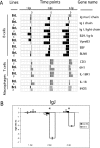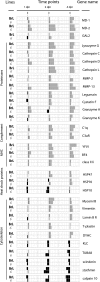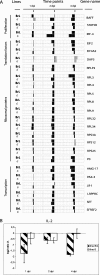Transcriptional profiling reveals a possible role for the timing of the inflammatory response in determining susceptibility to a viral infection
- PMID: 16940532
- PMCID: PMC1563900
- DOI: 10.1128/JVI.00929-06
Transcriptional profiling reveals a possible role for the timing of the inflammatory response in determining susceptibility to a viral infection
Abstract
Using a novel cDNA microarray prepared from sources of actively responding immune system cells, we have investigated the changes in gene expression in the target tissue during the early stages of infection of neonatal chickens with infectious bursal disease virus. Infections of two lines of chickens previously documented as genetically resistant and sensitive to infection were compared in order to ascertain early differences in the response to infection that might provide clues to the mechanism of differential genetic resistance. In addition to major changes that could be explained by previously described changes in infected tissue, some differences in gene expression on infection, and differences between the two chicken lines, were observed that led to a model for resistance in which a more rapid inflammatory response and more-extensive p53-related induction of apoptosis in the target B cells might limit viral replication and consequent pathology. Ironically, the effect in the asymptomatic neonatal infection is that more-severe B-cell depletion is seen in the more genetically resistant chicken. Changes of expression of many chicken genes of unknown function, indicating possible roles in the response to infection, may aid in the functional annotation of these genes.
Figures






Similar articles
-
Eimeria tenella: expression profiling of toll-like receptors and associated cytokines in the cecum of infected day-old and three-week old SPF chickens.Exp Parasitol. 2012 Apr;130(4):442-8. doi: 10.1016/j.exppara.2012.01.013. Epub 2012 Feb 4. Exp Parasitol. 2012. PMID: 22326592
-
Identification of differentially expressed genes in early stages of Eimeria tenella by suppression subtractive hybridization and cDNA microarray.J Parasitol. 2010 Feb;96(1):95-102. doi: 10.1645/GE-2221.1. J Parasitol. 2010. PMID: 19747019
-
Long noncoding RNA profiling reveals that LncRNA BTN3A2 inhibits the host inflammatory response to Eimeria tenella infection in chickens.Front Immunol. 2022 Aug 25;13:891001. doi: 10.3389/fimmu.2022.891001. eCollection 2022. Front Immunol. 2022. PMID: 36091044 Free PMC article.
-
Gene expression profiles of two B-complex disparate, genetically inbred Fayoumi chicken lines that differ in susceptibility to Eimeria maxima.Poult Sci. 2009 Aug;88(8):1565-79. doi: 10.3382/ps.2009-00012. Poult Sci. 2009. PMID: 19590070
-
Temporal transcriptome changes induced by MDV in Marek's disease-resistant and -susceptible inbred chickens.BMC Genomics. 2011 Oct 12;12:501. doi: 10.1186/1471-2164-12-501. BMC Genomics. 2011. PMID: 21992110 Free PMC article.
Cited by
-
Deciphering desirable immune responses from disease models with resistant and susceptible chickens.Poult Sci. 2019 Apr 1;98(4):1634-1642. doi: 10.3382/ps/pey535. Poult Sci. 2019. PMID: 30534980 Free PMC article. Review.
-
Chicken Mesenchymal Stem Cells and Their Applications: A Mini Review.Animals (Basel). 2021 Jun 24;11(7):1883. doi: 10.3390/ani11071883. Animals (Basel). 2021. PMID: 34202772 Free PMC article. Review.
-
RNAi pathways contribute to developmental history-dependent phenotypic plasticity in C. elegans.RNA. 2013 Mar;19(3):306-19. doi: 10.1261/rna.036418.112. Epub 2013 Jan 17. RNA. 2013. PMID: 23329696 Free PMC article.
-
Genome-wide analysis of differentially expressed mRNAs, lncRNAs, and circRNAs in chicken bursae of Fabricius during infection with very virulent infectious bursal disease virus.BMC Genomics. 2020 Oct 19;21(1):724. doi: 10.1186/s12864-020-07129-1. BMC Genomics. 2020. PMID: 33076825 Free PMC article.
-
Highly multiplexed quantitative PCR-based platform for evaluation of chicken immune responses.PLoS One. 2019 Dec 3;14(12):e0225658. doi: 10.1371/journal.pone.0225658. eCollection 2019. PLoS One. 2019. PMID: 31794562 Free PMC article.
References
-
- Beug, H., A. von Kirchbach, G. Doderlein, J. F. Conscience, and T. Graf. 1979. Chicken hematopoietic cells transformed by seven strains of defective avian leukemia viruses display three distinct phenotypes of differentiation. Cell 18:375-390. - PubMed
-
- Boardman, P. E., J. Sanz-Ezquerro, I. M. Overton, D. W. Burt, E. Bosch, W. T. Fong, C. Tickle, W. R. Brown, S. A. Wilson, and S. J. Hubbard. 2002. A comprehensive collection of chicken cDNAs. Curr. Biol. 12:1965-1969. - PubMed
-
- Bumstead, N., and B. J. Millard. 1992. Variation in susceptibility of inbred lines of chickens to seven species of Eimeria. Parasitology 104:407-413. - PubMed
Publication types
MeSH terms
Substances
LinkOut - more resources
Full Text Sources
Medical
Molecular Biology Databases
Research Materials
Miscellaneous

